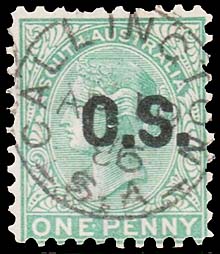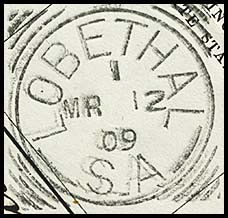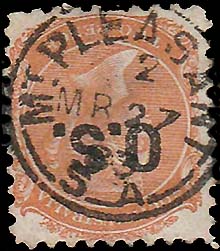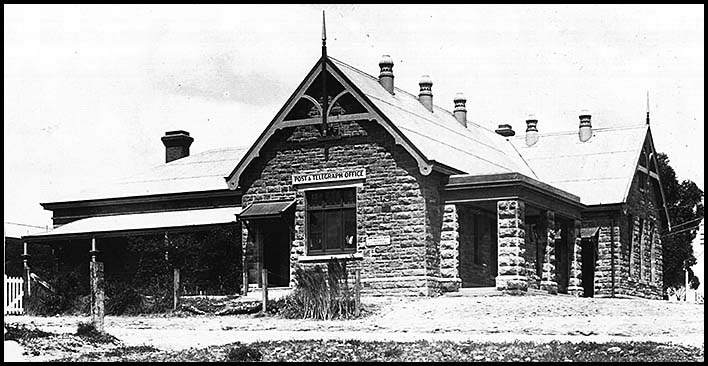Telegraph offices in the Mount Pleasant - Strathalbyn - Wellington region.
- Home, index, site details
- Australia 1901-1988
- New South Wales
- Overview of NSW
- Telegraph lines
- Telegraph Offices
- Date stamps
- Forms
- Envelopes
- Rates
- Stamps
- Queensland
- Overview of Qld
- Telegraph lines
- Telegraph offices
- Date stamps
- Forms
- Envelopes
- Rates
- Stamps
- South Australia
- Overview of SA
- Telegraph lines
- Telegraph Offices
- Date stamps
- Forms
- Envelopes
- Rates
- Stamps
- Tasmania
- Overview of Tasmania
- General developments
- Reports
- Organisation
- Telegraph lines
- Telegraph Offices
- Date stamps
- Railway lines
- Forms
- Envelopes
- Rates
- Stamps
- Overview of Tasmania
- Victoria
- Overview of Vic.
- Telegraph lines
- Telegraph offices
- Date stamps
- Forms
- Envelopes
- Rates
- Stamps
- Ephemera
- Western Australia
- Overview of WA
- Telegraph lines
- Telegraph Offices
- Date stamps
- Forms
- Envelopes
- Rates
- Stamps
The following Telegraph Offices are included in this page:
|
The Telegraph opened as Blumberg in February 1867. A Post Office had opened on 1 June 1855. On 1 July 1918, the name of the Office was changed to Birdwood. |
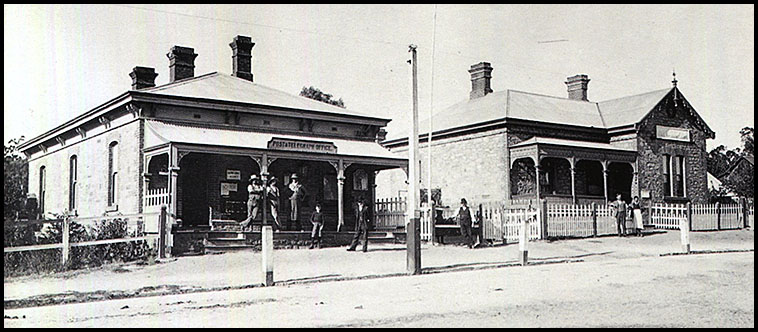 Birdwood Post & Telegraph Office about 1910. |
|
The Telegraph Office at Echunga was opened on 10 July 1873. Prior to that, there had been a number of petitions presented urging the opening of an office - especially as the line went past Echunga by that stage. The South Australian Chronicle of 6 May 1871 reported that during one of these meetings, the view was expressed that:
|
|
The first Telegraph Office was opened in 1862. The Foundation Stone for a new the Gumeracha Post Office and Telegraph Station was laid by Mr. H. Dawson, J.P. on 26 August 1878. Gold was often found in the area around Gumeracha along the banks of the Torrens River. In March 1867, an ingot was discovered containing about 13 ounces of gold. |
At a meeting between local residents and the Commissioner of Public Works. reported in the Adelaide Observer of 7 July 1877, the deputation wished
|
| Hahndorf.
The Telegraph Office opened in 1864. Also see the image in the Mount Barker entry below. |
|
|
|
Squared circle postal date stamp.
|
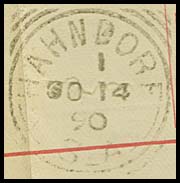 Hahndorf 14 October 1890. Used on SC-DO-7A. ERD for December 1889 printing of this form . |
|
The South Australian Chronicle of 8 March 1879 reported that a deputation had met with the Minister of Education on the precious day to ask that a telegraph station (and a school) might be erected at Kanmantoo. The Minister promised to lay the matter before his colleagues for consideration. The Telegraph Station opened on 2 September 1879. It closed on 1 February 1886. The Post Office had opened on 13 October 1855. |
|
A Post Office had opened as Langhorne's Creek on 1 August 1853. The Telegraph Office opened as Langhorne's Bridge on 5 October 1866 and was known by that name until the 1890s. In November 1898, the Telegraph Station was converted to a telephone office. In December 1940, the spelling was changed to Langhorne. At a meeting of the Central Road Board on 1 August 1860,a problem with the telegraph posts around Langhorne's Creek was raised:
It is not recorded if that reply fixed the problem. |
|
A Telegraph line was connected in 1866. Two years previously, Public Meetings had been held and the need for a Post & Telegraph Office was raised. For example, in November 1864, the meeting expressed the " hope that the Government will grant us the boon of a telegraph office, which will be much required this year, as a good deal of wheat will be purchased here." |
|
| When the line was completed to Macclesfield, the Post Office and Telegraph Office were located in a private store. There was considerable and long-standing dissatisfaction with this arrangement. For example, in October 1881, a deputation met with the Minister of Education and
In December 1883, a tender to construct a new Post & Telegraph Offices was let to T. Burnett for £695 2s 6d. |
|
|
In the House on 11 July 1872, Hon A. Blyth asked the Commissioner of Public Works "if the Government have received an offer of a gift of land for the Telegraph Station at Mannum. If so, when will the work of erecting a station at Mannum and making the line thereto be commenced?" The Commissioner of Public Works replied on the following day: "The Government have not received any offer of a gift of land for the Telegraph Station at Mannum. Instructions have been given for preparing plan of the Station and proceeding with the making of the line to Mannum." A Telegraph Office was opened on 3 February 1873.
|
|
|
The telegraph link to Mount Torrens was opened on 13 March 1867 but there was no Telegraph Station built by that time. The Station was closed in April 1886. The Post Office had opened on 25 July 1849, closed on 17 October 1850 and then reopened before March 1851. In August 1863, gold was found on the main road to Mount Torrens near the 20th milepost. The South Australian Register's Correspondent at Mount Torrens claimed to have visited the area for some years and was told that about three ounces had been washed out since 12 o'clock on the day he visited to check the latest story. It is nuggetty gold and was found near the surface. |
|
Murray Bridge had been a port on the Murray River but, in 1884, the landing at that port of any further material for the railway had to be discontinued. There was an excellent landing place near by the bridge but it was very low down and it was difficult to off-load heavy items. An alternative port therefore had to be found. A more suitable place was determined to be 15 miles further down the river "at a place called Tailem Bend". At that place, a tableland of rock extended inland for a long distance and "the iron road" came close to the river. The South Australian Weekly Chronicle of 20 June 1895 reported that "The railway station buildings are now nearly completed and that part of them to be used as a Post and Telegraph Office will be fitted up very soon. We hope to have the long-looked-for telegraphic facilities almost at once". The same newspaper reported on 11 July 1885 that:
The Telegraph Office was opened on Saturday 25 July 1885 by both Mr. Squires and Mr. Knuckey. |
|
|
|
On 7 August - soon after opening - the Mount Barker Courier noted:
In November 1913, the Offices were transferred from the Railway Station to an old school building pending the construction of new premises. Originally the town was called Mobilong which changed to Edwards Crossing. The name Murray Bridge was adopted in 1924. The road bridge across the Murray River had been constructed in 1879 and then converted to a road and rail bridge in 1886 |
|
Murray Bridge squared circle.
|
|
SC1: Steel circular date stamp.
|
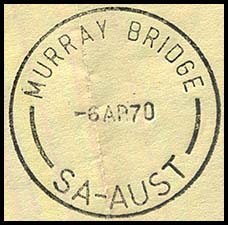 6 April 1970. Used on AA-DO-13D. |
|
The Telegraph Office was opened on 4 December 1873. A Post Office had been opened on 1 November 1868. |
|
|
In the second half of 1859, £778 was placed on the Estimates for the Telegraph Station and Post Office - for work to be commenced immediately. The Telegraph Office was opened on 29 June 1860 by Mr. Charles Todd. The site had been a great point of contention. The new Telegraph Office was completed about 18 August. On 1 November 1860, a young messenger - Mr. Waddy - was appointed to the new office after having passed his oral and public examinations. |
||
SC1: Steel circular date stamp.
|
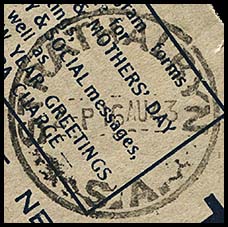 16 August 1943. Used on delivery envelope AB-EO-8. |
|
SC1: Steel circular date stamp.
|
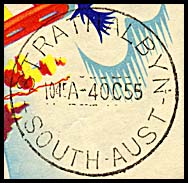 4 October 1955. Used on Congratulations form (AW-GCF-54Ab). |
|
|
The Post & Telegraph Office opened on 20 May 1880.
|
In August 1879, a Parliamentary delegation of 12 members inspected the building proposed for conversion into the new Teatree Gully Post & Telegraph office. They had left Parliament House "in two traps" and arrived about two hours later. The building had previously been known as the Highercombe Hotel and it stood on the rise of a hill facing the East Torrens Road but a little way back. The Register noted that "It had been urged by some members that the building was totally unsuitable and was in a very rlcketty tumble-down condition, and whispers that a job had been perpetrated were circulated freely amongst those disaffected towards the Government." The hotel stood on 1.5 acres and had originally cost between £3,000 and £4,000 to build. It was sold to the Government for £600. The delegation arrived to inspect inside the building but were told the key had been left in Adelaide:
|
|
The Telegraph Office opened in 1863.
Clearly for a river based port such as Wellington, the ferry was important. The ferry at Wellington had however been involved in a major fire in 1868. As a result, a new crossing of the River Murray was proposed at Mason's rather continue with a "present unsatisfactory and expensive ferry at Wellington". The Central Roads Board replied as follows:
More was to be learnt about the ferry and the Post and Telegraph Office. The South Australian Chronicle of 14 June 1871 reported:
The Mount Barker Courier of 14 September 1888 commented on mail deliveries as follows:
|
|
The telegraph link was completed in 1860. In 1866, the residents were still petitioning the Government to build a Post & Telegraph Office at Woodside. A Post Office had opened in 1857. The Adelaide Observer of 6 June 1860 reported on a public meeting at Onkaparinga in which a deputation of persons in and near Woodside brought before the Council
In August 1863, gold in paying quantities was discovered at North Woodside. In the House on 14 November 1884, Mr. Rees asked
|
